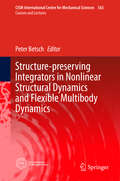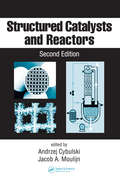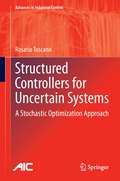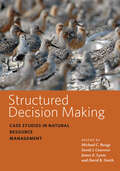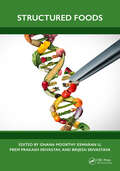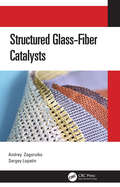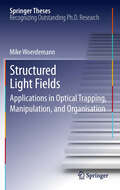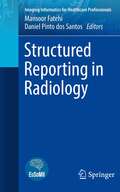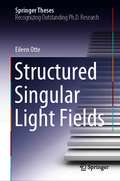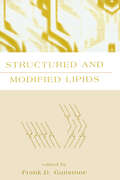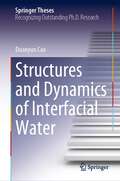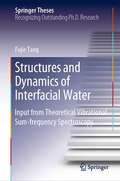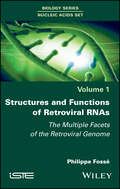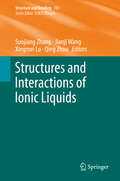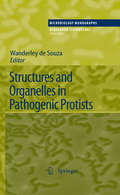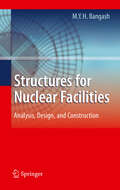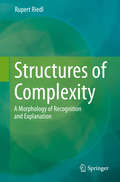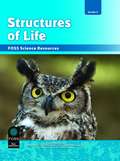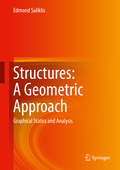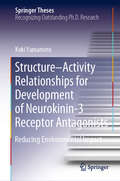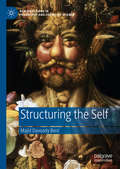- Table View
- List View
Structure-preserving Integrators in Nonlinear Structural Dynamics and Flexible Multibody Dynamics
by Peter BetschThis book focuses on structure-preserving numerical methodsfor flexible multibody dynamics, including nonlinear elastodynamics andgeometrically exact models for beams and shells. It also deals with the newlyemerging class of variational integrators as well as Lie-group integrators. Itdiscusses two alternative approaches to the discretization in space ofnonlinear beams and shells. Firstly, geometrically exact formulations, whichare typically used in the finite element community and, secondly, the absolutenodal coordinate formulation, which is popular in the multibody dynamicscommunity. Concerning the discretization in time, the energy-momentum methodand its energy-decaying variants are discussed. It also addresses a number ofissues that have arisen in the wake of the structure-preserving discretizationin space. Among them are the parameterization of finite rotations, theincorporation of algebraic constraints and the computer implementation of thevarious numerical methods. The practical application of structure-preservingmethods is illustrated by a number of examples dealing with, among others,nonlinear beams and shells, large deformation problems, long-term simulationsand coupled thermo-mechanical multibody systems. In addition it links novel timeintegration methods to frequently used methods in industrial multibody systemsimulation.
Structured Biological Modelling: A New Approach to Biophysical Cell Biology
by Bernhard Wolf Michael KrausStructured Biological Modelling presents a straightforward introduction for computer-aided analysis, mathematical modelling, and simulation of cell biological systems. This unique guide brings together the physiological, structural, molecular biological, and theoretical aspects of the signal transduction network that regulates growth and proliferation in normal and tumor cells. It provides comprehensive survey of functional and theoretical features of intracellular signal processing and introduces the concept of cellular self-organization. Exemplified by oscillatory calcium waves, strategies for the design of computer experiments are presented that can assist or even substitute for time-consuming biological experiments. The presented minimal model for proliferation-associated signal transduction clearly shows the alterations of the cellular signal network involved in neoplastic growth. This book will be useful to cell and molecular biologists, oncologists, physiologists, theoretical biologists, computer scientists, and all other researchers and students studying functional aspects of cellular signaling.
Structured Catalysts and Reactors (Chemical Industries)
by Jacob A. Moulijn Andrzej CybulskiInterest in structured catalysts is steadily increasing due to the already proven, as well as potential, advantages of these catalysts. Updating the comprehensive coverage of the first edition published in 1998 with the latest science and applications, Structured Catalysts and Reactors, Second Edition gives detailed information on all aspect
Structured Controllers for Uncertain Systems
by Rosario ToscanoStructured Controllers for Uncertain Systems focuses on the development of easy-to-use design strategies for robust low-order or fixed-structure controllers (particularly the industrially ubiquitous PID controller). These strategies are based on a recently-developed stochastic optimization method termed the "Heuristic Kalman Algorithm" (HKA) the use of which results in a simplified methodology that enables the solution of the structured control problem without a profusion of user-defined parameters. An overview of the main stochastic methods employable in the context of continuous non-convex optimization problems is also provided and various optimization criteria for the design of a structured controller are considered; H , H2, and mixed H2/H each merits a chapter to itself. Time-domain-performance specifications can be easily incorporated in the design.
Structured Decision Making: Case Studies in Natural Resource Management (Wildlife Management and Conservation)
by David R. SmithProvides and analyzes real examples of how structured decision making (SDM) can help solve complex problems involving natural resources.When faced with complicated, potentially controversial decisions that affect our environment, many resource management agencies have come to realize the value of structured decision making (SDM)—the systematic use of principles and tools of decision analysis. Few professionals, however, have extensive experience implementing SDM. Structured Decision Making provides key information to both current adopters of the method and those who are deploying it for the first time by demonstrating the formal use of decision analysis to support difficult, real-world natural resource management decisions. Drawing on case studies from multiple public agencies in the United States, Canada, Australia, and Mauritius, the editors present an overview of decision analysis, a classification of decision types, and a catalog of decision analysis methods. Dozens of detailed charts and maps help contextualize the material. These case studies examine a rich variety of topics, including• keeping forest birds free from disease• conserving imperiled freshwater mussels• managing water for oil sands mining• dealing with coastal wetlands in the face of sea-level rise• designing networks for prairie-dependent taxa• combatting invasive alpine shrubs• managing vernal pool habitats for obligate amphibian species • and much moreAimed at decision makers tackling natural resource challenges in government agencies around the world, as well as advanced undergraduate and graduate students preparing to work in natural resource management, Structured Decision Making shows how SDM can be implemented to achieve optimal outcomes that integrate social values and scientific understanding.Contributors: Taber D. Allison, Larissa L. Bailey, Ellen A. Bean, Clint W. Boal, Gregory Breese, Stefano Canessa, Jean Fitts Cochrane, Sarah J. Converse, Cami S. Dixon, John G. Ewen, Christelle Ferrière, Jill J. Gannon, Beth Gardner, Adam W. Green, Justin A. Gude, Victoria M. Hunt, Kevin S. Kalasz, Melinda G. Knutson, Jim Kraus, Graham Long, Eric V. Lonsdorf, James E. Lyons, Conor P. McGowan, Sarah E. McRae, Michael S. Mitchell, Clinton T. Moore, Joslin L. Moore, Steven Morey, Dan W. Ohlson, Charlie Pascoe, Andrew Paul, Eben H. Paxton, Lori B. Pruitt, Michael C. Runge, Sarah N. Sells, Terry L. Shaffer, Stephanie Slade, David R. Smith, Jennifer A. Szymanski, Terry Walshe, Nicolas Zuël
Structured Foods
by Prem Prakash Srivastav Eswaran U, Gnana Moorthy Brijesh SrivastavaStructured Foods is an important reference that discusses the recent research trends on structural development in various foods. This book covers different tools and food engineering techniques such as encapsulation, 3D and 4D printing, imaging techniques, and clean meat technology. It discusses how various foods can be broken down and manipulated at the molecular level to improve their quality, safety, and healthfulness. It describes the structuring of components like starch, proteins, and polysaccharides and the stability and bioavailability of different food structures. This is a useful reference for researchers and industry experts in food technology, food engineering, and food processing.The work addresses critical food-related issues that need to be tackled, including harvesting enough food to feed the global population, improving food sustainability, reducing food waste and pollution, and improving human health. Further, it focuses on the new scientific technologies being applied by scientists for an improved food system. The book is an important resource for all stakeholders in the debate about the future of our foods in the spheres of academic, industrial, and government policy.
Structured Glass-Fiber Catalysts
by Andrey Zagoruiko Sergey LopatinStructured Glass-Fiber Catalysts discusses the synthesis of advanced glass-fiber catalysts for various emerging applications, investigation of their properties, and development of the engineering basis required for their wide practical application. This book describes how to create and use such catalysts for different chemical reactions. It discusses how to efficiently arrange them into structured catalytic cartridges and gives examples of their successful application for purification of waste gases from different hazardous contaminants and environmentally safe combustion of fuels. It covers nanosize surface science fundamentals through large-scale commercial catalytic reactors. This book is aimed at researchers and engineers in the fields of chemical engineering, industrial engineering, and materials engineering.
Structured Light Fields
by Mike WördemannThe optical trapping of colloidal matter is an unequalled field of technology for enabling precise handling of particles on microscopic scales, solely by the force of light. Although the basic concept of optical tweezers, which are based on a single laser beam, has matured and found a vast number of exciting applications, in particular in the life sciences, there are strong demands for more sophisticated approaches. This thesis gives an introductory overview of existing optical micromanipulation techniques and reviews the state-of-the-art of the emerging field of structured light fields and their applications in optical trapping, micromanipulation, and organisation. The author presents established, and introduces novel concepts for the holographic and non-holographic shaping of a light field. A special emphasis of the work is the demonstration of advanced applications of the thus created structured light fields in optical micromanipulation, utilising various geometries and unconventional light propagation properties. While most of the concepts developed are demonstrated with artificial microscopic reference particles, the work concludes with a comprehensive demonstration of optical control and alignment of bacterial cells, and hierarchical supramolecular organisation utilising dedicated nanocontainer particles.
Structured Reporting in Radiology (Imaging Informatics for Healthcare Professionals)
by Mansoor Fatehi Daniel Pinto dos SantosThis book provides practitioners and scientists with insights into diverse aspects of structured reporting to allow them to develop tools and a knowledge base to ensure that this electronic reporting trend is widely applied. After an introduction to reporting in radiology, various parts of structured reporting are discussed in detail, including an overview of standardized reporting systems, standardized reporting language, DICOM structured reporting, template based structured reporting, and modular reporting. The last chapter addresses the interaction of structured reporting with artificial intelligence and its impact on the future of radiology. The last chapter addresses the interaction of structured reporting with artificial intelligence and its impact on the future of radiology. Endorsed by the European Society of Medical Imaging Informatics (EuSoMII), the scope of the book is based on the Medical Imaging Informatics sub-sections of the European Society of Radiology (ESR) European Training Curriculum Level I and II. It is a valuable resource for residents, radiologists and students.
Structured Singular Light Fields (Springer Theses)
by Eileen OtteStructured singular light is an ubiquitous phenomenon. It is not only created when light refracts at a water surface but can also be found in the blue daytime sky. Such light fields include a spatially varying amplitude, phase, or polarization, enabling the occurrence of optical singularities. As structurally stable units of the light field, these singularities are particularly interesting since they determine its topology. In this excellent book, the author presents a pioneering study of structured singular light, thereby contributing many original approaches. Especially in the field of polarization and its rich number of different types of singularities the book defines and drives a completely new field. The work demonstrates how to control complex polarization singularity networks and their propagation. Additionally, the author pioneers tightly focusing vectorial beams, also developing an urgently needed detection scheme for three-dimensional nanoscale polarization structures. She also studies classical spatial entanglement using structured light, introducing entanglement beating and paraxial spin-orbit-coupling. The book is hallmarked by its comprehensive and thorough way of describing a plethora of different approaches to structure light by amplitude, phase and polarization, as well as the important role of optical singularities.
Structured and Modified Lipids
by Frank D. GunstoneThis text addresses critical topics in the expanding market and production for lipids. It combines novel and traditional methods from technological and biological perspectives to achieve the most effective pathways for production of modified lipids. The book is organized into three sections exploring development, new production methods and successful products and uses.Structured and Modified Lipids provides a comprehensive exploration of issues related to lipids production and marketing. It combines novel and traditional methods from technological and biological perspectives to achieve the most effective pathways for production of modified lipids. The book is organized into three sections highlighting development, new production methods
Structures and Dynamics of Interfacial Water (Springer Theses)
by Duanyun CaoThis thesis highlights the study into the structures and dynamics of interfacial water, which is a cutting edge issue in condensed matter physics. Using the first principles calculation, classical molecular dynamics simulation and the simulation of atomic force microscopy (AFM), combined with the experimental results of AFM, the book systematically studies interfacial water at the atomic scale, especially the structure and growth mechanism of two-dimensional ice on hydrophobic Au (111) surface, the structure and the interconversion of the Eigen/Zundel hydrated proton on the Au(111) and Pt(111) surfaces, the microstructure and the hydration effect of the diffusion of ion hydrates on NaCl surface. This book displays the atomic scale information about the interaction between water and surface, and achieves many innovative results. Furthermore, the research methods included in this book can be further extended to study the more complex interfacial systems.
Structures and Dynamics of Interfacial Water: Input from Theoretical Vibrational Sum-frequency Spectroscopy (Springer Theses)
by Fujie TangThis book focuses on the study of the interfacial water using molecular dynamics simulation and experimental sum frequency generation spectroscopy. It proposes a new definition of the free O-H groups at water-air interface and presents research on the structure and dynamics of these groups. Furthermore, it discusses the exponential decay nature of the orientation distribution of the free O-H groups of interfacial water and ascribes the origin of the down pointing free O-H groups to the presence of capillary waves on the surface. It also describes how, based on this new definition, a maximum surface H-bond density of around 200 K at ice surface was found, as the maximum results from two competing effects. Lastly, the book discusses the absorption of water molecules at the water–TiO2 interface. Providing insights into the combination of molecular dynamics simulation and experimental sum frequency generation spectroscopy, it is a valuable resource for researchers in the field.
Structures and Functions of Retroviral RNAs: The Multiple Facets of the Retroviral Genome
by Philippe FosseOne family of viruses is responsible for the infection of many species of vertebrates. These are the retroviruses whose genomic RNA is used to support genetic information and ensures many essential functions that are required for the formation of an infectious viral particle. These functions depend on structures formed by the folding of the genomic RNA. Structures and Functions of Retroviral RNAs describes the formation of these structures and their specific interactions with nucleic acids and proteins. In light of recent advances in molecular virology, it provides an understanding of the various facets of the retroviral genome. It emphasizes in particular that the study of the structure–function relationship of retroviral RNAs is a driving force behind increased research into HIV-1, the main causal agent of AIDS. Indeed, one of the challenges of pharmacology lies in the exploitation of several targets which allow us to anticipate and stem the emergence of resistance to anti-HIV drugs. The book also presents structures and interactions that may be potential future targets in this regard.
Structures and Interactions of Ionic Liquids
by Qing Zhou Suojiang Zhang Jianji Wang Xingmei LuStructures, Bonding and Hydrogen Bonds, by Kun Dong, Qian Wang, Xingmei Lu, Suojiang Zhang Aggregation in System of Ionic Liquids, by Jianji Wang, Huiyong Wang Dissolution of Biomass Using Ionic Liquids, by Hui Wang, Gabriela Gurau, Robin D. Rogers Effect of the Structures of Ionic Liquids on Their Physical-Chemical Properties, by Yu-Feng Hu, Xiao-Ming Peng Microstructure study of Ionic liquids by spectroscopy, by Haoran Li Structures and Thermodynamic Properties of Ionic Liquids, by Tiancheng Mu, Buxing Han
Structures and Organelles in Pathogenic Protists
by W. De SouzaParasitic protozoa, including some which are agents of human and veterinary diseases, display special cytoplasmic structures and organelles. Metabolic pathways have been discovered in these organelles which open up new possibilities for drug targets. This work presents reviews dealing with cytoskeletal structures such as the mastigont system found in trichomonads, the sub-pellicular microtubules in trypanosomatids and the paraflagellar rod. Further chapters cover structures involved in the synthesis, secretion and uptake of molecules, including the flagellar pocket of trypanosomatids, the reservosome of Trypanosoma and the megasome found in Leishmania, the traffic of vesicles in Entamoeba histolytica, secretory organelles and the secretory events of intestinal parasites during encystation. Reviews on special organelles, such as the kinetoplast-mitochondrion complex, the apicoplast found in Apicomplexa, the glycosomes in Kinetoplastida and the acidocalcisomes found in several protozoa complete the volume.
Structures for Nuclear Facilities
by M.Y.H. BangashThis book provides a general introduction to the topic of buildings for resistance to the effects of abnormal loadings. The structural design requirements for nuclear facilities are very unique. In no other structural system are extreme loads such as tornadoes, missile and loud interaction, earthquake effects typical in excess of any recorded historical data at a site, and postulated system accident at very low probability range explicitly, considered in design. It covers the whole spectrum of extreme load which has to be considered in the structural design of nuclear facilities and reactor buildings, the safety criteria, the structural design, the analysis of containment. Test case studies are given in a comprehensive treatment. Each major section contains a full explanation which allows the book to be used by students and practicing engineers, particularly those facing formidable task of having to design complicated building structures with unusual boundary conditions.
Structures of Complexity: A Morphology of Recognition and Explanation
by Rupert RiedlIn this book, the author Rupert Riedl investigates the structural and functional correlations of issues considered as "complex". He brilliantly analyzes the definition of complexity, the occurrence of complexity, the meaning of complexity, and last-but-not-least the way complexity is dealt with professionally.In recent years, our view of the world has been split into ever smaller segments – in part due to the increasing importance of the natural sciences and their associated analytical power. This calls for once again focusing on complexity and the holistic aspects, on interdisciplinary and synoptic approaches. This book is a translation of the original German version “Strukturen der Komplexität”, which was published in 2000. The discussion of complexity from the perspective of a biologist has long been overdue when it was published and is still up-to-date.
Structures of Life
by Lawrence Hall of Science University of California at BerkeleyNIMAC-sourced textbook
Structures of Life
by Lawrence Hall of Science University of California at BerkeleyNIMAC-sourced textbook
Structures of Life (FOSS Science Resources)
by Delta Education<p>FOSS Science Resources is a book of original readings developed to accompany each module. The readings are referred to as articles in the Investigations Guide. Students read the articles in the book as they progress through the module. <p>The articles cover a specific concept usually after that concept has been introduced in an active investigation. The articles in FOSS Science Resources and the discussion questions provided in the Investigations Guide help students make connections to the science concepts introduced and explored during the active investigations. Concept development is most effective when students are allowed to experience organisms, objects, and phenomena firsthand before engaging the concepts in text. The text and illustrations help make connections between what students. </p>
Structures: Graphical Statics and Analysis
by Edmond SaliklisGraphic methods for structural design essentially translate problems of algebra into geometric representations, allowing solutions to be reached using geometric construction (ie: drawing pictures) instead of tedious and error-prone arithmetic. This was the common method before the invention of calculators and computers, but had been largely abandoned in the last half century in favor of numerical techniques. However, in recent years the convenience and ease of graphic statics has made a comeback in architecture and engineering. Several professors have begun using graphic statics in the classroom.and.studio environment. But until now, there had been no guidebook that rapidly brings students up to speed on the fundamentals of how to create graphical solutions to statics problems.Graphic Statics introduces all of the traditional graphic statics techniques in a parametric drawing format, using the free program GeoGebra. Then, advanced topics such as indeterminate beams and three dimensional curved surfaces are be covered. Along the way, links to wider design ideas are introduced in a succinct summary of the steps needed to create elegant solutions to many staticequilibrium problems.Meant for students in civil and architectural engineering, architecture,and construction, this practical introduction will also be useful to professionals looking to add the power of graphic statics to their work.
Structure–Activity Relationships for Development of Neurokinin-3 Receptor Antagonists: Reducing Environmental Impact (Springer Theses)
by Koki YamamotoThis book explores the possible development of neurokinin-3 receptor (NK3R) antagonists with reduced environmental impact. Pharmaceuticals are used to cure diseases and to alleviate symptoms in humans and animals. However, the stable, bioactive substances excreted by patients have unfavorable effects on non-target species. To overcome these disadvantages of these highly stable, potent substances, drug design to turn off bioactivity after release into the environment is needed. The book describes the development of eco-friendly NK3R antagonists by introducing a labile functional moiety and substituting a scaffold. This resulted in a novel NK3R antagonist that oxidized into its inactive form when exposed to air. Further, the book presents an efficient and easily achievable synthetic method of creating triazolopiperazine scaffolds, as well as a structure–activity relationship study involving scaffold hopping for decomposable motifs, which led to a novel photodegradable NK3R antagonist. Demonstrating that it is possible to develop compounds that convert into their inactive forms under environmental conditions, this book is useful for anyone interested in therapeutic agents with reduced environmental impact.
Structuring the Self (New Directions in Philosophy and Cognitive Science)
by Majid Davoody BeniThis book presents a unified account of the self, based on a network of knowledge sourced from several scientific accounts of selfhood. Beni constructs his ontological account of the self from the common structure that underpins the theoretical diversity that is manifested in rival and sometimes incompatible scientific accounts of the self and its aspects. The enterprise is inspired by recent structural realist theories in the philosophy of science, specifying the basic structure of the self, and explaining how representational, phenomenal, and social aspects of the self are embodied within this structure.
